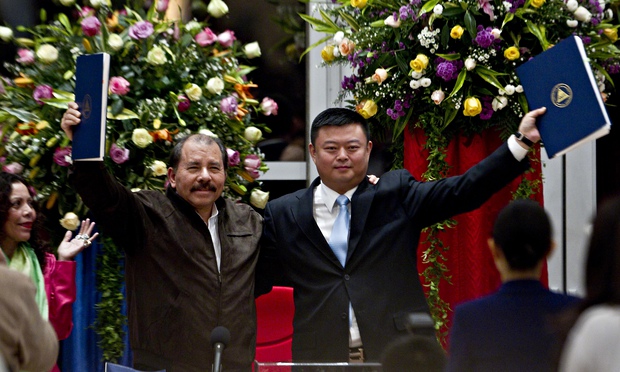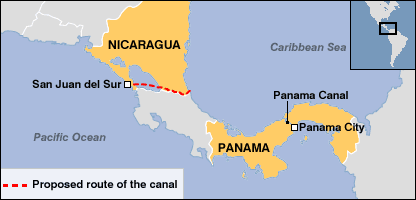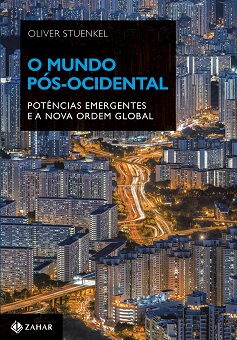
Nicaragua’s President Daniel Ortega and Wang Jing, president of HKND, the Chinese company that promises to build the Nicaragua Canal
——————-
Whoever possesses the passage between the two oceans can consider himself the owner of the world.
Hernán Cortés, in a letter to Spain’s King Carlos V
Nicaragua can become, better than Constantinople, the necessary route of the great commerce of the world.
Napoleon
——————-
Last January, construction of the so-called Grand Interoceanic Canal (usually called Nicaragua Canal), has finally begun. If completed, the canal would be the largest civil-engineering and construction project in the history of mankind, spanning 276 kilometers across the Central American nation.
The idea of building a canal in Nicaragua is not new. As Jon Lee Anderson writes, Cornelius Vanderbilt, a U.S. tycoon, had taken a strong interest in the project.
Soon, the United States took up the idea of a canal, and U.S. Congress began trying to decide whether to build it in Panama or Nicaragua. In 1901, the Nicaraguan government gave the U.S. government exclusive rights to build a canal there. But before the issue went to a vote the chief of the powerful pro-Panama lobby mailed each U.S. senator a one-centavo Nicaraguan postage stamp, featuring an image of Lake Managua, luridly illuminated by an exploding volcano. Panama, which had no volcanoes in the canal zone, won by a margin of eight votes.
Complete humiliation for Nicaragua would follow in 1914, when, in exchange for 3 million US dollars, Nicaragua’s President Emiliano Chamorro granted the U.S. government the exclusive right to build a Nicaraguan canal. The agreement essentially prevented Nicaragua from building a canal to compete with the Panama Canal. The treaty was only abolished in the 1970s. Since then, Nicaraguan leaders have dreamed of turning the canal into a reality, partly in the hope that it would promote development in the second-poorest country in the Western Hemisphere.
It would take the previously unknown businessman Wang Jing, with likely approval and support of the Chinese government, to revive the project. Wang’s Hong Kong-listed company HKND now holds a 100-year-long concession over the canal’s operation. The cost of the construction is officially estimated at forty billion dollars, even though experts believe the total cost will be closer to one hundred billion dollars. Even the feasibility studies conducted so far have cost several hundred million dollars, suggesting Wang’s confidence. Wang has hired the China Railroad Construction Corporation, a company that has overseen the construction of the Three Gorges Dam in China.
The project’s financial viability is questionable, and its environmental consequences could be disastrous. The Nicaragua Canal could accommodate ships capable of carrying up to 25,000 containers, which may increasingly be the norm, thus successfully competing with the Panama Canal, which can only accommodate ships carrying 13,000 containers. Competition would reduce shipping prices and boost trade.
Yet China’s objectives are more likely to be geopolitical. HKND is exempt from local taxes and commercial regulations, and has been granted hiring and land-expropriating powers. Along with the concession to build the canal, Wang now holds the rights to the build large seaports on both coasts, new airports, railroads and highways. He has also won contracts to build a new telecommunications network. The plan also includes a free trade zone. Notably, a recently approved reform overturned a constitutional stricture against foreign soldiers being garrisoned in Nicaragua, in theory paving the way for a Chinese military base — even though such a step seems extremely unlikely in the short or medium-term, as Beijing has no interest in openly challenging the United States.
Considering that it is not officially behind the project, and that the upfront cost was relatively small, the Chinese government could still step back from the project if political or logistical problems arose. It would thus be premature to regard the Nicaragua Canal project as part of a global version of what some analysts describe as the “string of pearls”, a network of Chinese military and commercial facilities in the Indian Ocean.
Yet if Wang succeeds in building the canal, the geopolitical consequences for the region would be significant. The project will employ at least fifty thousand workers, many of whom will be Chinese. At a recent OAS Summit, US Secretary of State John Kerry famously told the region’s leaders that the era of the Monroe Doctrine was over. And indeed, the US government has not commented much on China’s plans in Nicaragua, beyond asking for more transparency. The creation of a massive Chinese footprint in Latin America, however would still alter regional dynamics far more than any of the previous partnerships China has set up with governments in the region.
Read also:
Book review: “The Boxer Rebellion and the Great Game in China” by David J. Silbey
Photo credit: AP









